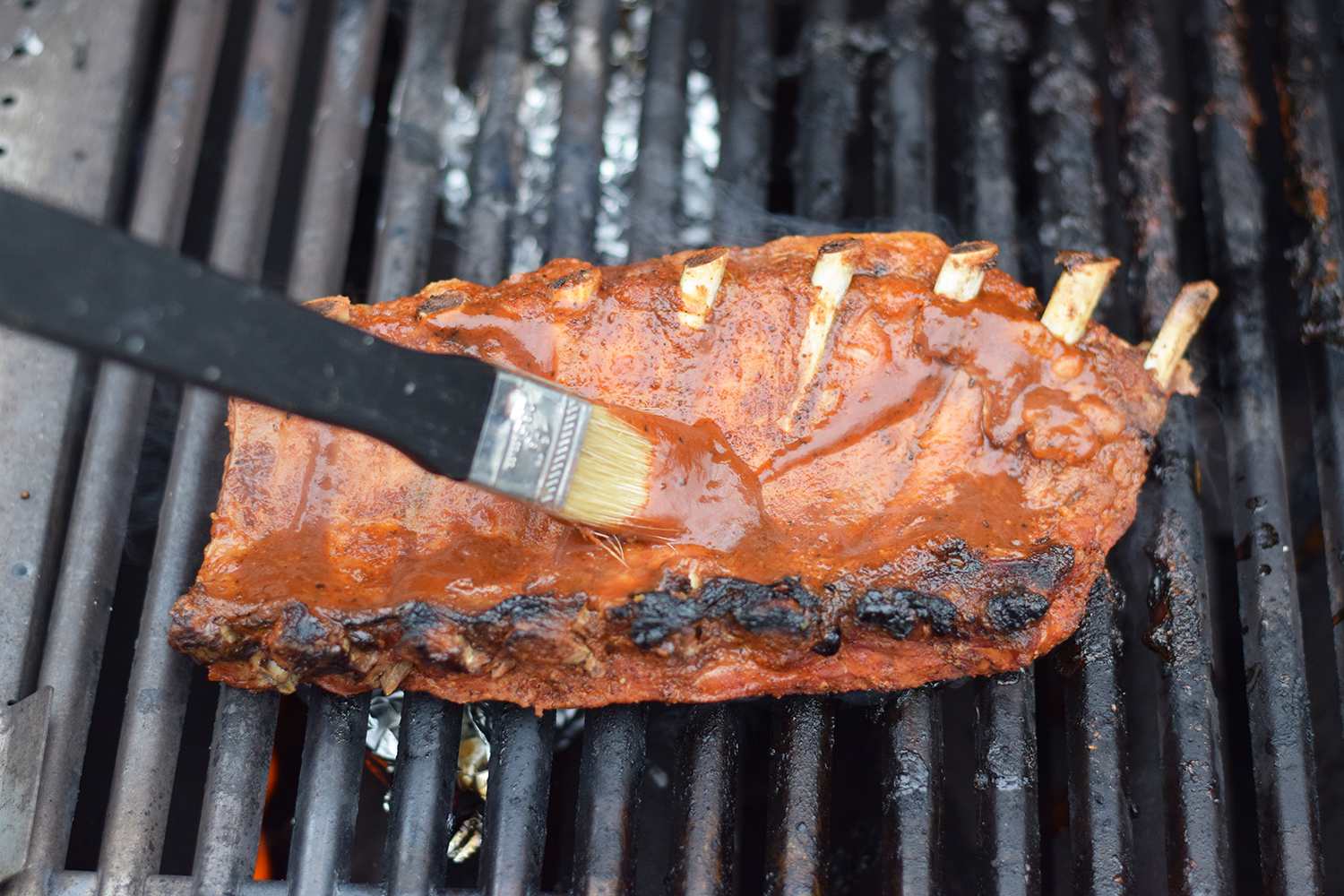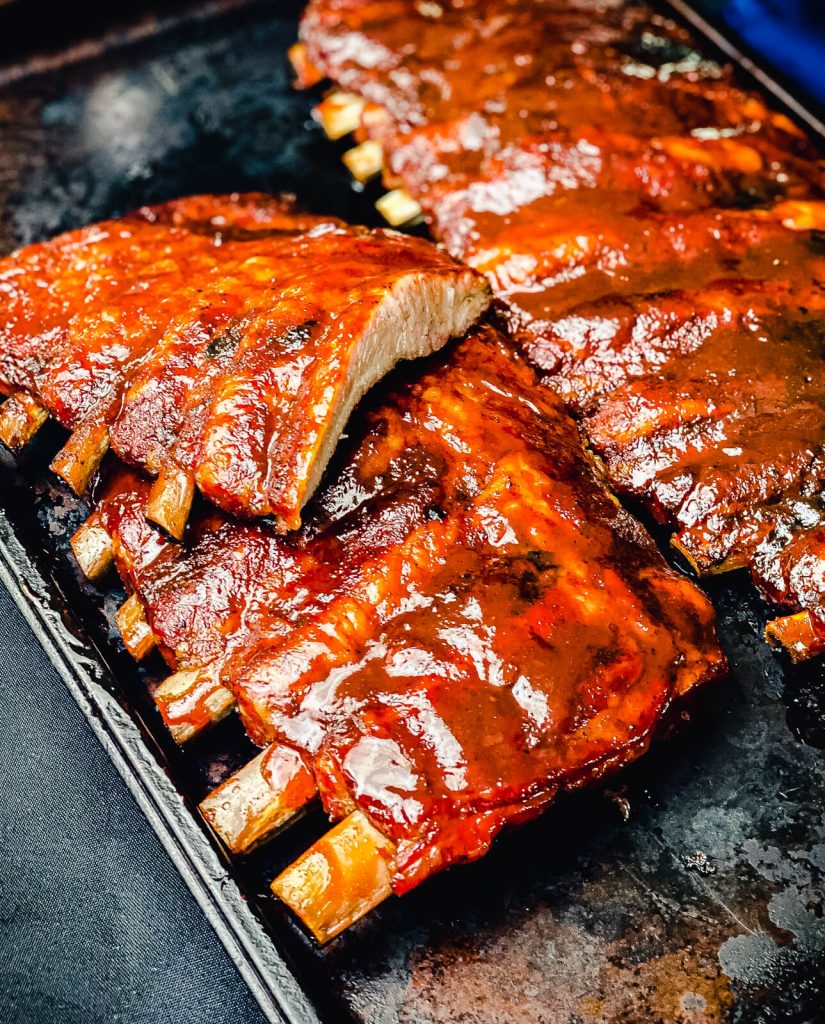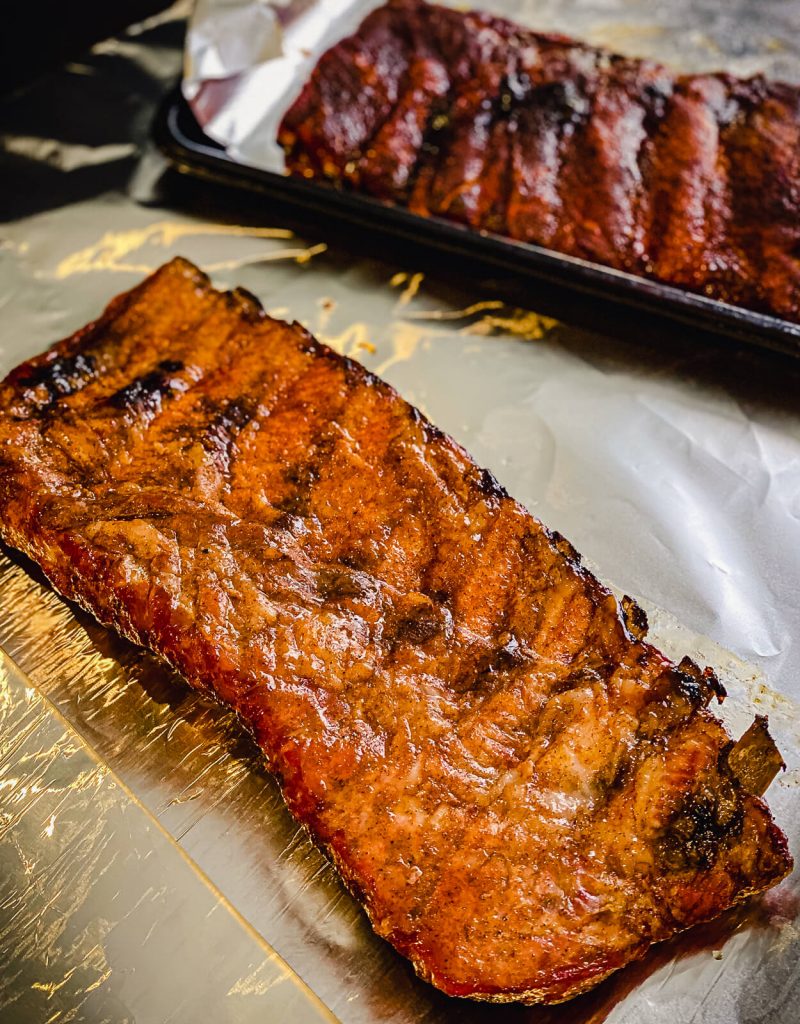“How can I make BBQ ribs on a gas grill?” has been a question I get asked a lot since I started this blog. A lot of people think it’s not possible. That’s not the case. In this blog, I’ll show you how to bbq ribs on a gas grill.
Right now, I like grilling with charcoal, adding smoke to some meats, and taking care of a fire. I also know not everyone, most people in fact, don’t have a charcoal grill. So this blog is all about teaching you how to barbecue ribs on a gas grill.
Here, you’ll learn the principles of low and slow cooking on a gas grill. That’s why the steps are the same whether you’re grilling baby back ribs or spare ribs.
At the end of the blog I’ll offer some tips for making bbq ribs on a gas grill. I strongly encourage you to read those carefully. It’ll take just minutes and you’ll get some great value from those.
Grilling juicy flavorful pork ribs may seem intimidating, but it’s easier than you think with the right techniques. Pork ribs can easily dry out and toughen on the grill if you don’t know what you’re doing. However with a few simple tips, you’ll be making competition-worthy ribs in your own backyard in no time. This complete guide will walk you through every step needed for mouthwatering grilled pork ribs using a gas grill.
Benefits of Grilling Ribs on a Gas Grill
While grilling purists may prefer charcoal, there are some distinct advantages to using a gas grill for ribs:
-
Easier temperature control – Gas grills allow you to precisely set the temperature and make adjustments as needed. With charcoal temperature often spikes and drops.
-
No mess – Gas grills avoid the ash and mess of charcoal while still infusing smoke flavor.
-
Convenience – Gas grills heat up faster and eliminate waiting for coals. You can grill ribs any time without preparation.
-
Safety – Gas grills are generally safer, especially for beginners, since there’s no fire starter fluid or messy ashes.
While gas can’t replicate the exact charcoal flavor, the results are very close with the right techniques. The control of gas makes it easier to avoid overcooking.
Tips for Grilling Ribs on a Gas Grill
Grilling great ribs requires patience and the right process. Here are tips to ensure tender, juicy results:
-
Remove membrane – Cut away the thin papery membrane from the back of the ribs for better smoke and rub penetration.
-
Use indirect heat – Ribs should not be cooked directly over the flames. Use indirect heat to prevent burning.
-
Cook slow – Ribs need to cook low and slow. Keep the temperature 225-250°F for best results.
-
Use a rib rack – A rib rack holds the ribs upright for more even cooking since the underside won’t overcook.
-
Add smoke – Use wood chips or chunks in a smoker box to infuse smoke flavor as ribs cook. Soak chips first.
-
Spritz ribs – Mist ribs with apple juice or other liquid periodically to keep them moist during long cooks.
-
Wrap in foil – The Texas crutch method steams ribs in foil after a few hours to make meat extra tender.
-
Check doneness – Use bend and twist tests rather than relying only on temperature to determine doneness.
-
Rest ribs – Let ribs sit for 10-15 minutes after grilling before cutting for juicier meat.
Step-by-Step Guide for Grilling Pork Ribs
Follow these simple steps for finger-licking ribs every time on your gas grill:
1. Choose Rib Type
Select the right cut of ribs for your preference:
-
Baby back – More tender, leaner meat from upper rib near the spine. Shorter cooking time.
-
Spareribs – Fattier with more connective tissue but more flavor. Need longer, slower cooking.
-
St. Louis – Trimmed spareribs for rectangular shape. Ideal balance of meaty and tender.
2. Remove Membrane
Trim off any excess fat or cartilage. Use a knife to loosen the membrane then pull it off the bone side of the rack.
3. Apply Dry Rub
Coat ribs all over with a dry rub at least an hour before grilling (can be night before). Choose your favorite spice mix or make your own.
4. Allow Ribs to Reach Room Temp
Remove ribs from fridge 30 minutes before grilling so they grill more evenly. Don’t skip this important step.
5. Prep Grill for Indirect Heat
Heat only one burner on high for 10 minutes. Place ribs on unlit side so not directly over flame.
6. Add Smoke Wood
Soak 1-2 cups wood chips in water for 30 minutes then add to a smoker box or foil pouch over lit burner.
7. Grill Ribs Slow and Low
Cook ribs at 225-250°F for best results. Place a drip pan under ribs. Close lid.
8. Flip and Rotate Ribs
Flip ribs over every 45-60 minutes for even cooking. Also rotate rack for uniform results.
9. Spritz Ribs
Use a spray bottle to mist ribs with apple juice or other liquid every hour as they cook.
10. Wrap Ribs in Foil (Optional)
After 2-3 hours, wrap rack tightly in foil with apple juice and grill for 1 hour. Steams for tenderness.
11. Unwrap and Sauce Ribs
Unwrap ribs if using foil method. Baste ribs with barbecue sauce during last 15-30 minutes.
12. Check for Doneness
Use bend test or check meat shrinkage. Temp should be 195°F-205°F. Juices should be clear.
13. Let Ribs Rest
Remove ribs from grill and tent with foil for 10-15 minutes before cutting into portions.
14. Enjoy!
Slice between bones to serve. Don’t forget plenty of extra sauce for these spectacular grilled pork ribs!
Tips for Maximum Flavor
Beyond technique, flavor is what really makes ribs stand out:
-
Season early – Rub generous amounts of spice rub into the meat at least an hour before grilling.
-
Watch the sugar – Some recipes call for sugar but too much can burn easily on a gas grill. Limit added sugars.
-
Pick your wood – Apple, hickory, pecan, and cherry wood chips all add great smoke flavor.
-
Sauce wisely – Apply thicker, sticky sauce only during the last 15-30 minutes or it may burn.
-
Rest ribs – Never cut into hot ribs right off the grill. Resting helps juices redistribute for best texture.
-
Get creative – Experiment with different rubs, sauces, and smoke woods until you find favorites.
Troubleshooting Grilled Ribs
Having issues getting perfect results? Here are some common problems and solutions:
Ribs are tough and chewy – This happens when ribs are undercooked. Be sure to grill low and slow at 225-250°F for enough time depending on rib type. Baby backs need at least 4 hours while spareribs need 6 hours or more. Use a meat thermometer to confirm ribs reach 195°F-205°F.
Ribs are dry – Dryness is caused by overcooking or ribs that weren’t kept moist. Wrap ribs in foil with liquid to steam and tenderize meat after a few hours. Also, spritz ribs with apple juice every hour. Don’t discard rendered rib fat.
Ribs stick to the grill – Prevent sticking by properly oiling the grill before cooking. Use a rib rack to elevate ribs off direct contact. Gently scrape any stuck areas after cooking or while saucing.
Ribs have burnt spots – Avoid flare-ups by cooking over indirect heat, trimming excess fat, keeping lid closed, and watching sugar in rubs/sauces. Move ribs to avoid direct heat exposure.
Ribs lack flavor – Maximize flavor with a savory rub that permeates the meat. Smoke with wood chips the entire cook time. Finish with thicker, sticky sauce for a flavor boost.
Frequently Asked Questions
Get answers to common questions about grilling pork ribs:
How long does it take to grill ribs on a gas grill?
It takes around 4-5 hours for baby back ribs and 6-7 hours for spareribs cooked at a low indirect heat of 225-250°F. Cook times vary based on thickness. Use bend and twist tests to determine doneness rather than only relying on time.
What temperature do you cook ribs on a gas grill?
Keep your gas grill between 225-250°F for tender, fall-off-the-bone ribs. Avoid direct heat over 300°F. Use indirect heat and close the lid to maintain the ideal rib cooking temp.
Do you sear ribs on a gas grill?
Searing over high direct heat is not necessary with ribs. It can lead to burnt outsides before the insides cook through. Use low indirect heat between 225-250°F the entire time for juicy, tender results.
How can you add smoke flavor when grilling ribs on a gas grill?
Add soaked wood chips or chunks to a smoker box or foil pouch placed over the lit burner to infuse ribs with smoky flavor. Keep the smoke going the entire cook time, adding more wood as needed.
Should the membrane be removed from ribs before grilling?
Yes, stripping off the thin membrane from the back of the rack allows rub and smoke to better penetrate the meat. Use a knife to loosen it first. Removing it also prevents the membrane from shrinking and curling the ribs.
Mastering

Tips For Making BBQ Ribs On a Gas Grill
The Wrap: Make sure you wrap the ribs tightly in foil or butcher paper to keep their beautiful color and make them tender.
The Thermometer: Don’t trust the thermometer that came with your grill; use a good leave-in thermometer to find out how hot it is where the ribs are cooking on the grill.
For the smoke, you can use pellets or wood chips, a fancy box or a foil packet. Just put it over the direct heat of the grill and it will make a nice smoke for your ribs. You don’t need to see so much smoke that you think something’s on fire. Clean smoke is almost transparent, and clean smoke is a must for good flavor.
Why It’s Dry: Because gas grills don’t seal like Kamado grills do, they tend to be pretty dry places to cook. This means you’ll need to spritz the ribs every hour to keep them moist.
The Zones: Two-zone cooking is a must. If you want to learn more about it, I suggest you read that blog post.
The Lid: Keep it closed as much as possible. Once you close the lid, don’t be peeking in on the ribs, no matter how tempting. That lets the heat and smoke out.
The Doneness: Check here for an in-depth look into how to tell when pork ribs are done. The bottom line, they should be super tender and juicy, but not “fall off the bone. ” You want to be able to bite into them, without the meat falling apart.
The Plan: Don’t just buy some ribs, and dive in. Do a test run with your grill and thermometer first. Know what position of the gas knob will achieve what temperature in the indirect zone of the grill. Don’t try to figure that out with ribs on the grill.
Overall: This blog is about the technique of setting up the grill. It’s not about the bbq sauce, the dry rub recipe, or the rib preparation or removing the membrane. For that information, I’d encourage you to read this blog about how to make barbecue ribs.

Should Ribs Be Wrapped in Foil When Grilling?
Absolutely! Wrapping pork ribs in aluminum foil or butcher paper isn’t simply for maintaining a beautiful color. They cook faster and become more tender when you wrap them. Wrapping them also breaks down the connective tissue.
There are some “basic” guidelines about when to wrap the ribs, using internal temperature for example. Usually internal rib temperature of around 160° – 165°F is a good time to wrap the ribs. If that’s what you’re comfortable with, roll with it.

I prefer to go by a visual inspection when determining when to wrap the ribs. I’m really looking for color and bones when I decide on when to wrap them up. They won’t go bad if you leave them out for too long, but they will get darker than most people like and take longer to cook.
There are a few bones sticking out from the side of the ribs, and the color is a nice bright red or mahogany. It’s time to wrap them up. This usually happens after about two hours on the grill.
